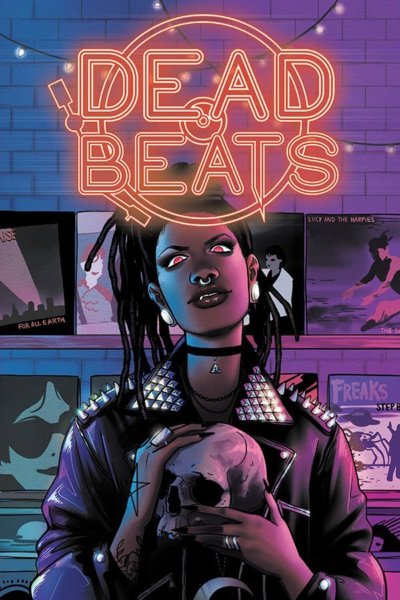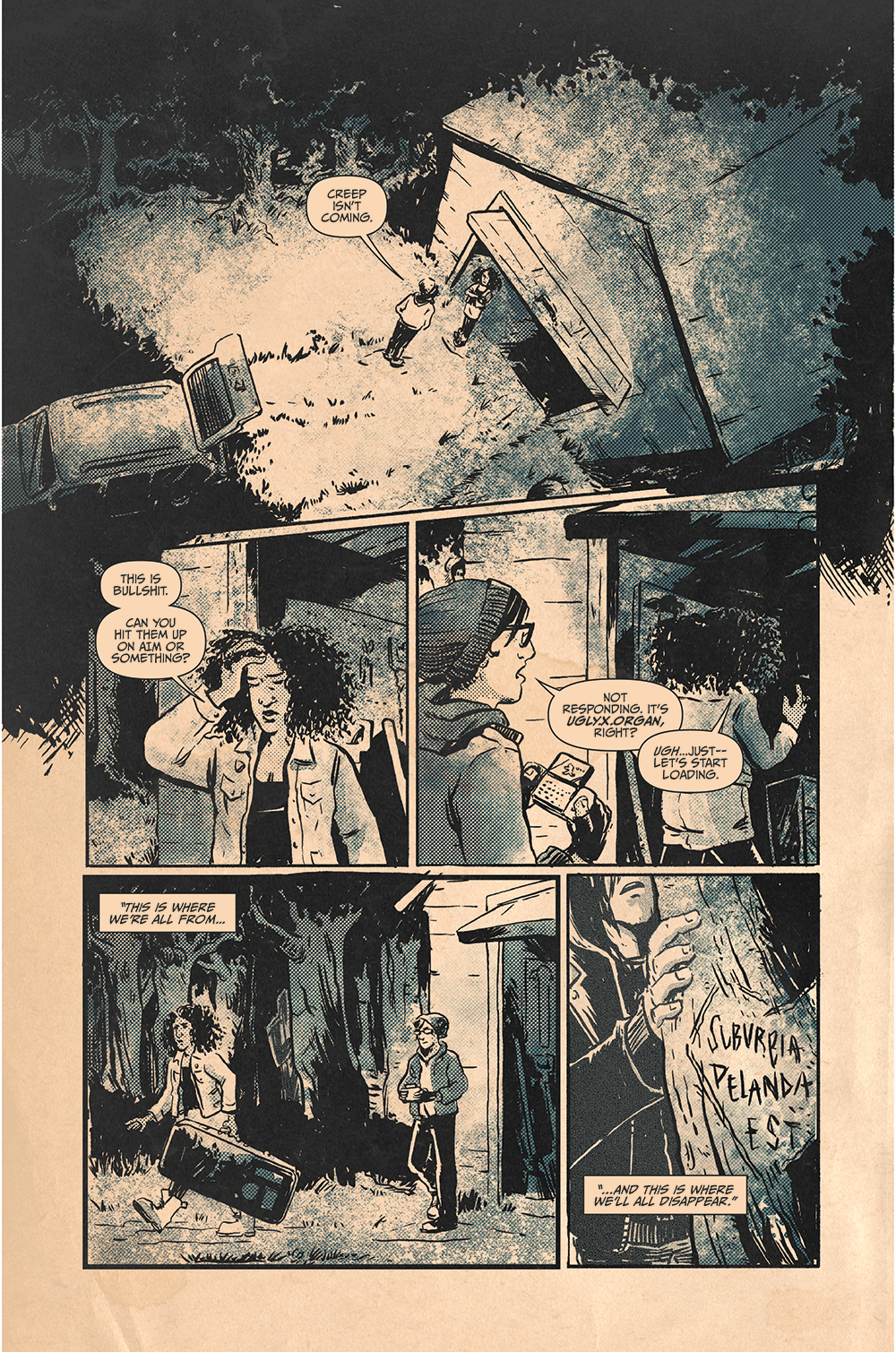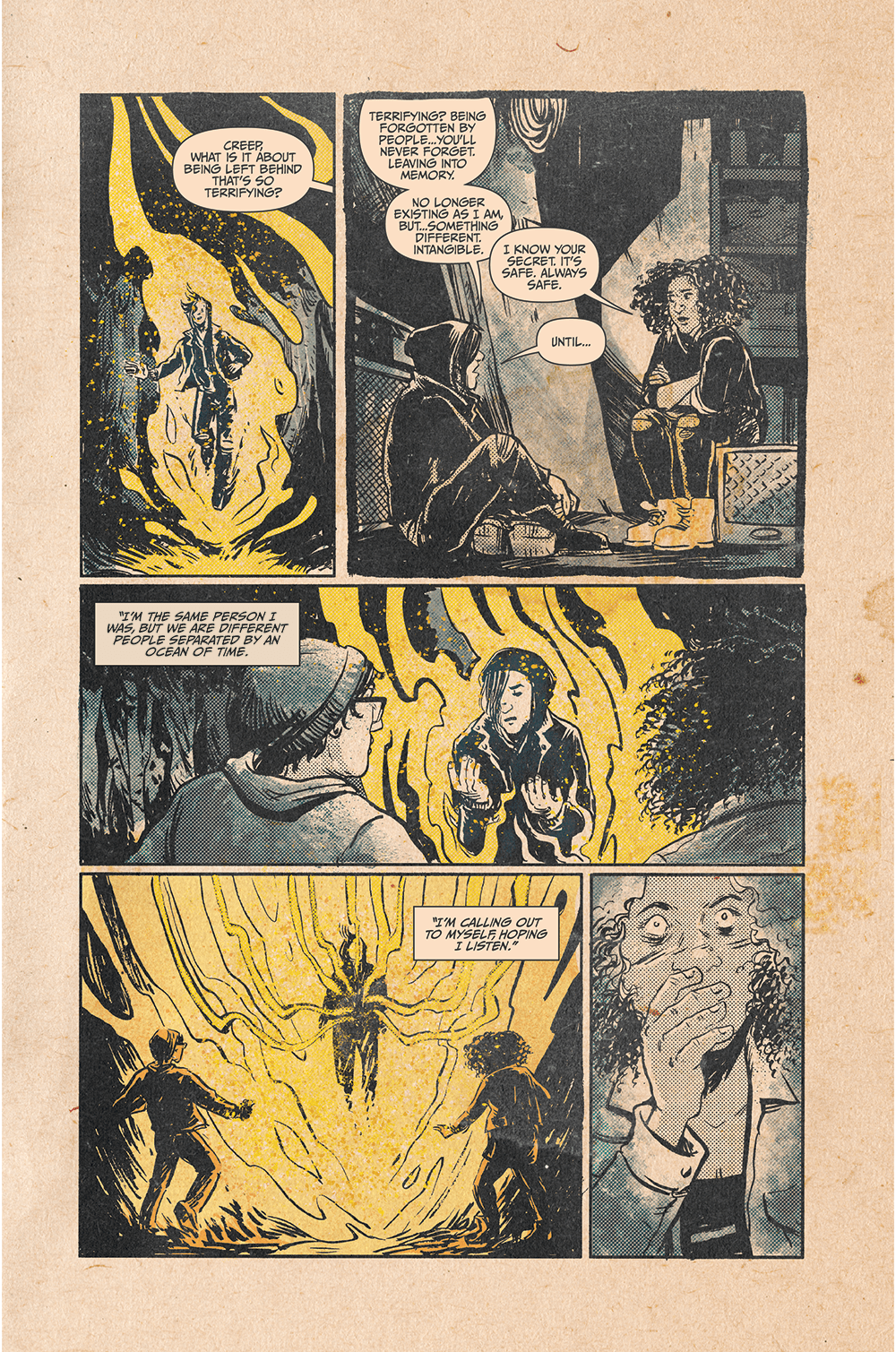Love music? Love horror? Same, which is why I was immediately drawn to Dead Beats, an upcoming comics anthology from A Wave Blue World. Collecting comics from talented creators like Christina “Steenz” Stewart, Daniel Kibblesmith, Rachel Pollack, Ivy Noelle Weir, and Vita Ayala, the anthology celebrates the spooky side of our favorite music genres.
Having greatly enjoyed Matthew Erman’s work on Long Lost, I was ecstatic to get to talk with him and co-creator Sally Cantirino about their contribution to the anthology, “Vanishing.”
Describe this comic in just three words.
Erman: Existential Emo Horror? I think?
I saw the Sidekick on the first page and knew that I was in for a treat. As an emo kid who refuses to grow up, tell me: what emo bands would you say had the most influence on this comic?
Erman: Oh man, there’s so many for me. This moment in time was so important to me growing up. I grew up in Dayton, Ohio, which just had an outrageous “scene,” both emo and hardcore. So like, I’m from the same hometown as Hawthorne Heights and a lot of my time in middle school and high school was spent going to local shows at Christian youth centers and watching local bands open for bigger acts like Underoath, Silverstein, and all that. I think those bands (quality notwithstanding) really influenced some part of this.
I think what really resonated with me growing up though was the more … I don’t even know how to put it. Emo music for kids that, like, were maybe a little too self-aware or pensive or reflective. So like Cursive, Thursday, Saosin, Thrice, My Chemical Romance, Taking Back Sunday, and things like that. A good portion is actually still quite good too, haha. The emotional core of the music is at the heart of “Vanishing,” I think, or I tried for it to be and yeah—it’s a horror story about some emo kids.
Cantirino: I grew up in central New Jersey, so halfway between NYC and Philly and also right near Starland Ballroom and Vintage Vinyl, Englishtown and Asbury Park. I lucked out and had incredible access geographically for going to shows in high school and college, and a mom who was cool with it. I was a little too young to have been around for the height of the scene in NJ but I caught the tail end of it in 2004. Out of just that scene, Saves The Day, Thursday, MCR, and Armor For Sleep all had an influence on this comic.
Given emo music’s kind of dark, sometimes violent lyrics and imagery, it seems like a natural choice for exploring in horror—but “Vanishing” doesn’t really take that easy route! Tell me a bit about the decision to make the band emo but not steer in the direction of, you know, “You could slit my throat / and with my one last gasping breath / I’d apologize for bleeding on your shirt.”
Erman: Working with Sally, it never felt right to skewer the genre or it never came up to kind of lampoon or poke fun at it because we both genuinely love this music. I think the culture was problematic and a lot of it championed male violence as a coping mechanism and misogyny against women. It feels like modern bands are aware of that and some are even addressing it in new albums (Jesse Lacey, I’m looking at you). I think those are really big themes and ideas for the era too, not just the music—it was a symptom of something bigger. So there where a ton of routes we could have gone down, and who knows, maybe Sally and I will return to this concept down the road for something and really dive into the era and time and the music.
Cantirino: Jumping right to being literal with graphic or violent lyrics would have felt a little too predictable. And making “emo kids” the punchline is so boring, 30-year-old men and high school boys in The Beatles shirts have been doing that since 2004, since I was a teenager. I think Matt and I worked well together on this because we came from a similar place of inspiration and genuine love.
We had discussed going more of a commentary route with the story when we were initially bouncing ideas around, but it’s hard to jam that into six pages and do it correctly. While that commentary and criticism is important, and you shouldn’t be blinded by your nostalgia and affection TOO much, it also just wasn’t the story I wanted to tell.
Tell me about the larger relationship between music and horror that’s at work in DEAD BEATS as a whole, but also within this comic in particular.
Erman: Sally and I really wanted to have a story that felt like it did to listen to this music—it’s big and hard to contain all the emotions you have as a teen, and CREEP is experiencing a lot of what I think I went through as a kid except on a much more horrifying scale. DEAD BEATS has done something really smart in combining the emotional languages that exist between these two different things. Horror is kind of its own language but it can take so many forms, same with just, I guess, music in general.
The comic is about a kid in trouble and his friends that have to move forward without him. “Vanishing” is terrifying and that’s what I think this is about. Leaving or being left behind, something there.
Cantirino: Music and comics and horror came into my life at the same time as a teenager, it’s all linked for me. It’s what you end up getting into when you get left unattended at the mall on a Friday night! Comics, music, and horror are all best when they’re made with an unironic, uncool love for the medium/genre or act of creating, when it’s genuinely a little lo-fi or rough around the edges.
The artwork has this very neat retro feel to it, including what look to be stains and spots on the page. What went into the choice to have it look a bit aged?
Cantirino: I wish I had a smarter answer than “I put a scan of some old paper into the file and liked how it looked!” It felt like it was missing something until I did that. I guess it ties into my previous answer of how I like when things look a little lo-fi, like the matte pulpy paper that comic trade paperbacks used to be printed on.
What goes into the character designs and dialog choices for a comic set in a different, but not totally distant, time like this? How do you put together something that’s reflective of the era?
Cantirino: Matt and I both would have been teenagers during that era, which is now … like … 10-15 years ago? It doesn’t feel that distant, it’s still extremely fresh in my mind, I don’t even think I needed a reference picture to draw a Sidekick. It doesn’t feel that far away, but then I’ll start chatting with someone standing next to me at a show and find out they weren’t even born yet when I went to my first show, and then I crumble to dust and blow away into the night.
The artwork has a lot of texture and just a few hints of color. Why take this approach with the comic?
Cantirino: My background is in self-publishing mini-comics and zines, and a little bit of printmaking. I’m used to working in black and white, halftones, limited palettes. If you’re trying to print things cheaply and your main tool is a photocopier or a Risograph with a limited number of color options, you adapt your style around those restraints. That approach ended up fitting the vibe of the story really well.
What drew you to this anthology and this story in particular?
Erman: I met Joe (Corallo) earlier this year at Emerald City and he’s a really cool dude. I can’t remember if he asked me before or after, but once he did, I knew I wanted to be part of this and I knew immediately that I wanted to work with Sally. I’d been following her for a while now and I was familiar with her work and what she kind of stories she seemed drawn to create and it felt like what I wanted to do and what she wanted to do were likely very similar.
Cantirino: I believe I met Joe Corallo through Liana Kangas—I was talking to Liana about meeting Richard Case and how much I love Doom Patrol, and she was like, “You should be friends with Joe.” I’d also been following Matt online because I really liked Long Lost, and everything just fit. Matt and I bounced around some ideas, including one that I had sitting on the shelf for a year or two—that one ended up becoming “Vanishing.”
Do you have experience as musicians? What’s it like to approach an audio medium as visual and written artists? What unique challenges does writing and illustrating music present?
Erman: I played in a band or two growing up—I play guitar and drums, so I’ve always been connected to music. It’s actually where I get most of my inspiration as a writer—sounds and textures and tone and moods. It helps put my head in the right creative space.
Cantirino: I ended up making comics because I couldn’t start a band. I’m a terrible singer and worse at guitar and even worse at making friends to start a band with. So I just started making art and comics inspired by the music I liked instead.
There are a couple of big challenges in translating what a live show feels and looks like into a narrative, graphic medium: walking the line between accuracy/specificity and not making yourself nuts with too much detail, trying to express the chaos of it without losing clarity, not falling into any visual cliches, drawing crowds. I’m always trying to make sure how I approach drawing it, inking it, and what route I go with colors or textures captures the energy of a live show. I have a huge backlog of photos and videos I’ve taken at shows over the last 15 years, so I have no shortage of reference to tap into.
What music should people listen to while reading “Vanishing”?
Erman: Sally made an awesome playlist for this comic, so listen to that. But if I had to pick one personal song it would 100% be Thursday’s “War All the Time.” I feel very strongly about this.
Cantirino: Can I pick three songs? “Walking At Night, Alone” by Armor For Sleep, “Pine Point” by PUP, and “Turning Over In My Tomb” by Saves The Day, in that order.
Is there anything else people should know about your comic or any other work you have coming up?
Erman: Sally is awesome to work with, highly recommend it. A Wave Blue World is awesome. This comic is part of an even more incredible whole and I’m so happy and grateful to be able to tell these kinds of stories. Which is to say that they are weird and strange and hard to articulate and terrifying. This was a highlight for my year.
Cantirino: I had a great time working with Matt and AWBW. I’m really lucky that Joe reached out to me and made this project possible.
Dead Beats is due out October 16, 2019, and is available for pre-order now with the Diamond code AUG191665.





